Light & Color
by Chris Hacking
Light attenuates so fast in water that, for a long time, I
didn't even try taking pictures using ambient light. Getting my
slave strobe working was a major step forward,
because the flash built in to my camera was only really effective to about 4
feet (1.3m) and few fish let me get that close. I have since learned a few
things, and now take most of my pictures while
snorkeling (shallow water) using ambient light.
The other light-related aspect of underwater photography is
color. On the surface, properly developed film will be close to the true colors
of the subject, assuming reasonable lighting (perhaps modified slightly by the
type of film used). Underwater, everything will appear blue unless very close to
the surface and to the camera. This has to do with the way water absorbs light;
red light is absorbed very quickly, while blue light can travel much further. In
fact, many seemingly drab underwater objects are actually rather colorful in
white light! Since pictures that are nothing but shades of blue are not
extremely interesting, underwater photographers use various means to restore the
missing vibrant reds, oranges, and yellows.
A flash or strobe is one common way to solve both problems.
A flash can allow high-speed, tight aperture photographs using low-ISO film (or
CCD setting) even on cloudy days or under
overhangs, and can restore an apparently grey/brown coral or purple fish to
bright, vivid red. However, there are significant disadvantages to using a flash
underwater: backscatter, short range, long
recharge time, and difficulties for automatic light meters.
White Balance: Overcoming the washed-out blue
effect can also be achieved with special lens filters or with an adjusted white
balance (WB). Filters actually reduce the available light, however, so they are
not recommended except in very bright environments. Changing the WB does not
increase or decrease the light the camera senses, it merely shifts its color (in
this case, towards red). Both filters and a custom WB are designed to compensate
for the loss of red light through a certain range of water, so what works fine
with ambient light in 10' (3m) of water may be completely blue under the same ambient
light in 40' (12m) because the red light is getting much more attenuated. Similarly,
it is possible to overcompensate and get photos that are more red than they
would be even on the surface.
| Deep water / Poor ambient light |
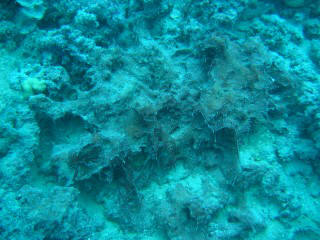
A sponge about 40 feet (12m) deep,
looking rather boring in ambient light.
|
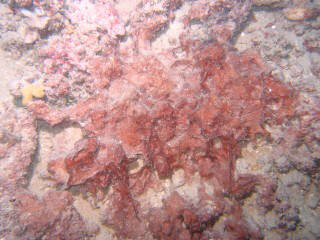
The same sponge, photographed this time
with the strobe, reveals its bright red color!
|
| (Below) Mid-level water / Good ambient light |
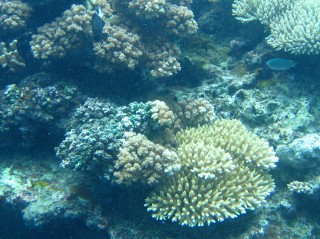
This coral cluster is mostly washed out by
nearly monochrome blue ambient light. |
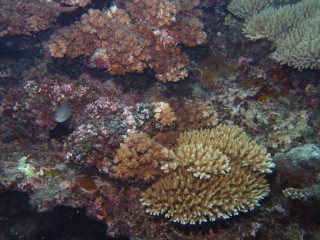
The same coral cluster, showing a much
greater range of colors with the strobe! |
Both of these pairs of pictures are of the
same target at about the same time. Both were taken using the same color
settings, at about the same angle and distance. Aside from differences
in aperture and shutter speed, the only difference is that the flash
(including my slave strobe) was used in taking the shots on the right.
No modifications (except shrinking) were made to either photograph after
it was taken.
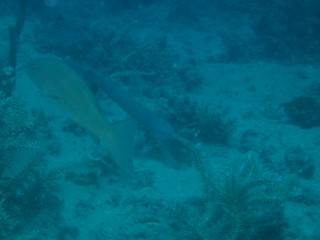
Because the fish were beyond flash range,
they are no brighter than the background. |
Flash Range: Using a
powerful strobe gives a reasonable range underwater (mine allows perhaps
12' or 3.6m), but anything beyond that range is going to be much too dark to
see. This not only prevents most wide-angle shots (impractical anyway because of
backscatter), it means that the photographer MUST compose the shot carefully,
placing the camera close enough to the target. Extending the flash's range in a
given water clarity probably means buying a more powerful and/or more focused
one; the light from the flash quickly becomes no brighter than the ambient light.
Recharge time is not always a problem, and some strobes
recharge quite quickly. However, most fish and some other marine creatures do
not appreciate bright flashes of light, and will flee at the first picture. If
it doesn't come out well, recomposing the shot can be tricky. This is especially
true while free diving, which can turn into a race between the strobe capacitor
and the need to breathe.
I was somewhat surprised to find that the automatic light
meter in my camera does not handle the slave strobe well. The built in flash
poses no problem, but the (rather unsophisticated) slave strobe does not seem to
work well with the automatic modes; most pictures come out underexposed!
Up | Why Digital? | Tools & Methods | Backscatter | Light & Color | Composing
Reef Animals | UW Photo How-to | Scuba Diving
Top Level:
Home |
Destinations |
Cruising Info |
Underwater |
Boat Guests |
Ocelot |
Sue |
Jon |
Amanda |
Chris |
Site Map |
Make a Comment
 |
Lifetime
Commodores
of the
Seven Seas
Cruising
Association |
 |
|
If our information is useful,
you can help by making a donation
|
Copyright © 2000‑ Contact:
Jon and Sue Hacking -- HackingFamily.com, svOcelot.com.
All rights reserved.






